How to keep your account from getting hacked
open allWhat for: So that attackers cannot crack it.
A Google account lets you synchronize music, photos, contacts, and other data across devices. However, if it is hacked, criminals will gain access to all of that data. Another danger is that if someone has access to your Google account, they can remotely lock out any connected devices and erase all data from them.
Make sure that your account is protected by a strong password that complies with the following requirements:
- Is at least 8 characters long;
- Contains lowercase and uppercase letters, numbers, and special characters ($, @, etc.);
- Is not an actual word or easy-to-guess phrase;
- Is not the same as your passwords for any other accounts;
- Does not consist of information that strangers could easily find out (your name, date of birth, pet's name, and so forth — or those of your friends or relatives).
To change the password:
- Open Settings on your device;
- Go to the Google section;
- Tap Manage your Google account;
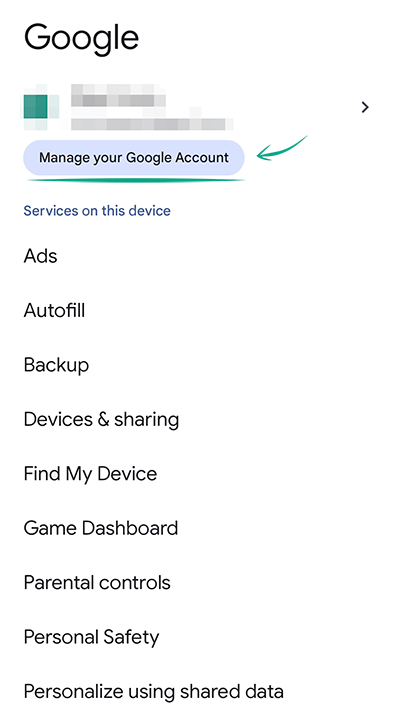
- Scroll to the right until you get to the Personal info tab;
- Select Password;
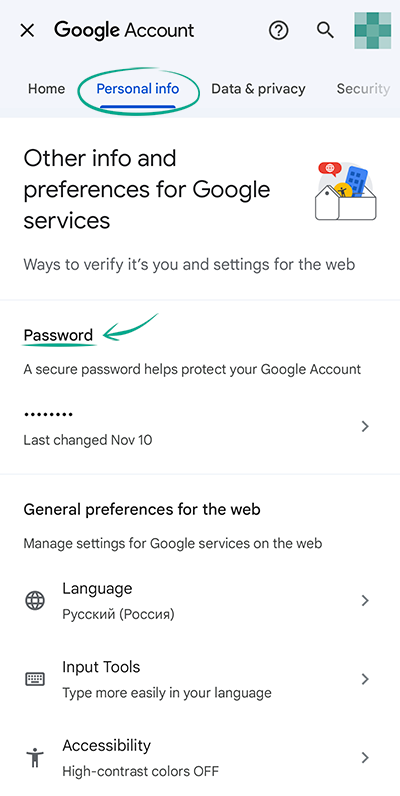
- Confirm your identity;
- Enter a new strong password twice and tap Change password.
What for: So you definitely don't get hacked.
You can increase the security of your Google account by enabling two-step verification. Every time you try to log in from a new device, the system will ask for a one-time code. A notification will be sent to all gadgets that are already logged in to that account. Thus, even if someone tries to hack your account, you will still be able to prevent them from logging in.
You can verify a login:
- Using a trusted device. When you try to log in to an account from an unknown device, a message will appear on the phone with your Google account asking you to verify the login. You'll find a list of devices that have attempted to log in but are awaiting verification on the Settings page;
- Using a one-time code received by text or a phone call;
- Using your phone's built-in security key. Please note that embedded electronic keys are supported only by devices with Android 7.0 or later. For them to work, the phone must be located next to your PC, and Bluetooth must be enabled on both devices.
To enable two-step verification using a trusted device:
- Open Settings on your device;
- Go to the Google section;
- Tap Manage your Google account;
- Scroll to the right until you get to the Security tab;
- Tap 2-Step Verification;
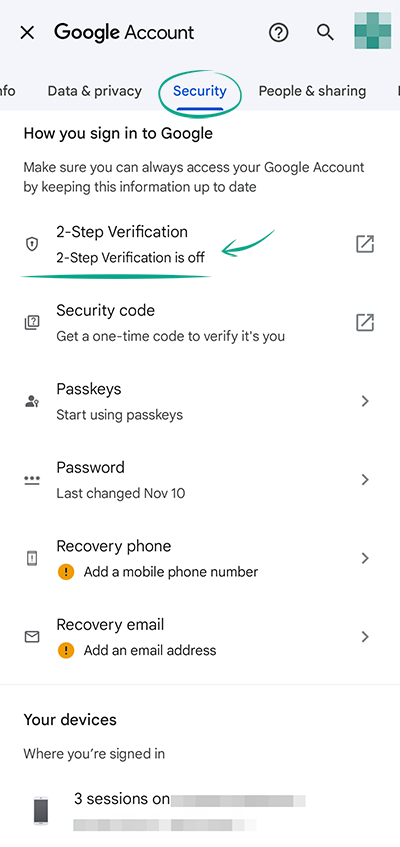
- Tap Get started;
- Enter your Google account password, or use your fingerprint, facial recognition, or screen lock. Tap Next;
Google will suggest two-factor authentication with your phone: When you try to log in to your account on a new device, messages will be sent to your logged-in devices.
- Check that the device is on the list;
- Tap Continue;
- You will be offered to add a backup sign-in method. To do this, enter the phone number that you want to use to receive text messages or phone calls with codes;
- Choose how you want to receive the code (SMS or Pone Call) and tap Next;
- Enter the code that you received by text or voice message and tap Next;
- Tap Turn on.
If you do not want to use this method, choose a text message or phone call as the means of verification:
- Tap Show more options;
- Select Text message or voice call;
- Enter the phone number that you want to use to receive SMS messages or phone calls with codes;
- Choose how you want to receive the code (SMS or Pone Call) and tap Next;
- Enter the code and tap Next;
- Tap Turn on.
To enable two-step verification using a security key, in the same section:
- Tap Show more options;
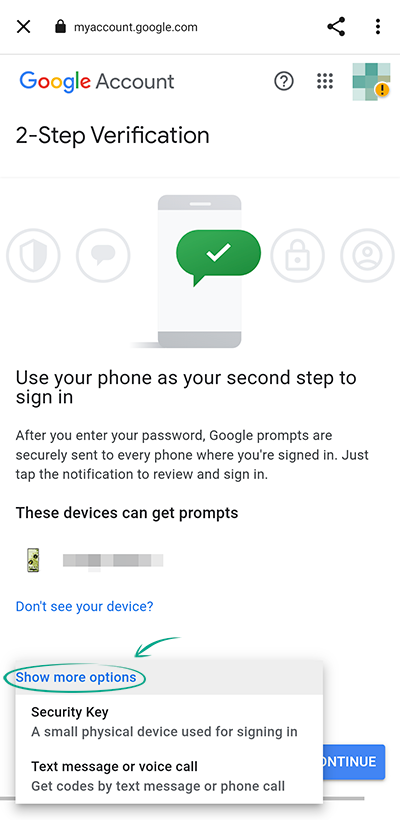
- Go to the Security key section with the name of your device and tap Done.
After you have enabled two-step verification, you can add several more login methods:
- Using backup codes that work even if your phone is not available;
- With the Google Authenticator app.
Use a trusted device, an incoming phone call, a special app, a security key, or backup codes for secure additional verification; A text message with the code can be intercepted by infecting the smartphone with malware or by exploiting a communication protocol vulnerability.
How to prevent your personal data from being exposed
open allWhat for: To keep strangers from learning too much about you.
Certain data — including your date of birth, gender, and phone number — from your account is visible to other users by default. To prevent strangers from viewing this information, deny access to it:
- Open Settings on your device;
- Go to the Google section;
- Tap Manage your Google account;
- Scroll to the right until you get to the Personal info tab;
- Scroll down the page and tap Go to About me;
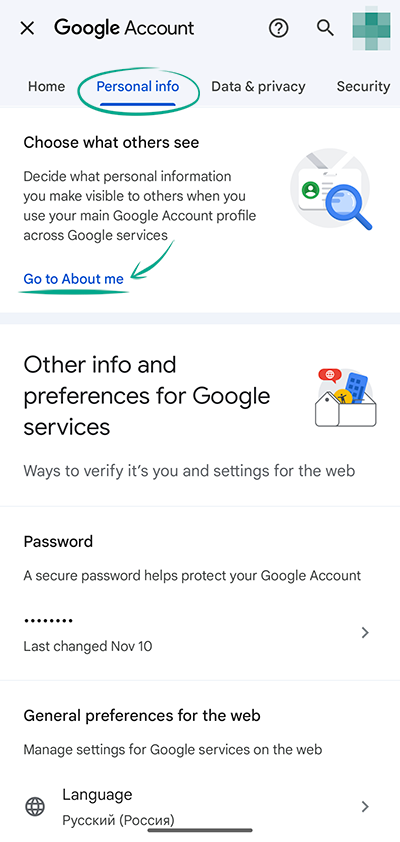
- Select the fields containing information that you want to deny access to, and specify that only you can see it.
You may not limit access to certain data, such as photos and names.
What for: To keep strangers from learning where you are.
Certain Google services can show your location to other users. By default, the feature is disabled. However, you can activate it by, for example, sending your current location to one of your contacts. We recommend reviewing who is allowed to access your location data and denying strangers access to it:
- Open Settings on your device;
- Go to the Google section;
- Tap Manage your Google account;
- Scroll to the right until you get to the People & sharing tab;
- Tap Manage location sharing in the Location sharing section;
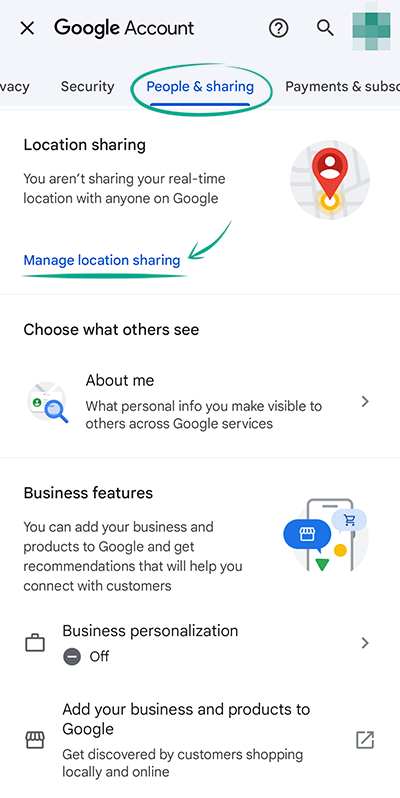
- Under What others can see, tap Stop next to the name of the user you want to prevent from accessing your location data.




